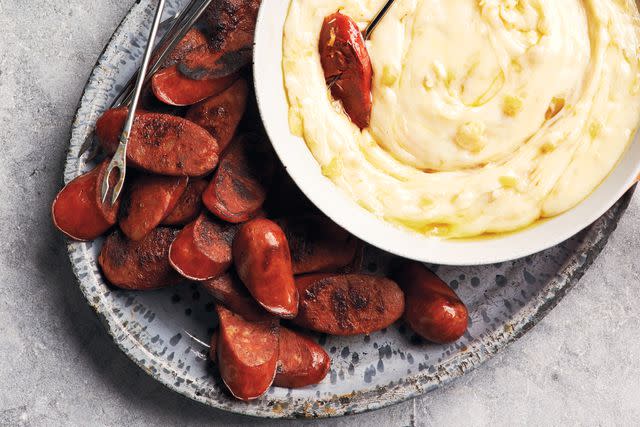What Is Chorizo? An Expert Shares How to Shop and Cook With the Spicy Sausage
Chorizo has a complex flavor that pairs well with everything from eggs to seafood.
You’ve probably noticed chorizo on restaurant menus, and you’ve likely seen it sold by the link at your local deli and in butcher shops, either fresh or cured. A spicy pork sausage, chorizo is used to impart a slightly smoky, complex flavor to all kinds of dishes, from traditional Spanish paella to brothy steamed mussels. It's also popular on charcuterie boards, pairing well with an assortment of cheeses. A versatile meat, chorizo can be used as the main protein in a dish like meatballs, served as an accompaniment to breakfast, or used as a garnish for soup, salad, or pasta (much like you would crumbled bacon).
We asked Angelica Intriago, co-owner of Despaña, a renowned Spanish food purveyor, to share her expertise on chorizo. Learn how chorizo is made and what you need to know to use this spicy sausage in your meals.
Meet Our Expert
Angelica Intriago is the co-owner of Despaña, a specialty Spanish food purveyor in New York City. Despaña is renowned for its chorizo, which is shipped internationally.
Related: 15 Chorizo Recipes to Add an Extra Kick to Your Dinner

David Malosh
How Chorizo Is Made
According to Intriago, chorizo is typically made by grinding or chopping pork, and sometimes also beef, chicken, or vegetables, to create a meat block. From there, the meat is mixed with a combination of flavorful spices (and sometimes fresh ingredients like garlic and onion), and stuffed into casings (either animal-derived or synthetic). The chorizo can be sold raw (like other links or patties of sausage you see at the supermarket), air-dried and cured (similar to salami), or fully cooked and ready-to-heat.
Types of Chorizo
There are an endless number of chorizos on the market, each with its own cultural specificities—and all strongly flavored. Spanish- and Mexican-style chorizos are the most widely available. Other countries, including Colombia, Argentina, Bolivia, and El Salvador, each have their own style that differs slightly from the rest, embracing local ingredients and spice blends that are reminiscent of their gastronomical culture.
No matter where chorizo is made, the sausage started out as a way to reduce waste and use each part of meat from an animal. The dry-curing process helped to preserve the sausage so it could be enjoyed year-round.
Spanish Chorizo
Intriago says Spanish-style chorizo is usually made with pork as the main ingredient and incorporates spices like garlic and smoked paprika, which is responsible for its deep rusty red color. Most Spanish chorizos are dry-cured, which means they have a much more salty and concentrated flavor—and can be sliced and eaten right out of the package, paired with with crusty bread and mustard, or lightly fried for tapas.
How to Use: The smoky flavor of Spanish chorizo pairs perfectly with seafood, another regional favorite. Thin slices of the dried sausage are an aromatic addition to white wine-bathed mussels, shrimp and rice pilaf, and perfectly cooked cod fillets. Eggs are another classic pairing—notably tortilla Española. Even better, the eggs can be repurposed the next day into a hearty sandwich.
Mexican Chorizo
Like its Spanish counterpart, Mexican-style chorizo is frequently made using pork as the main component. It tends to be a little less smoky and more spicy, thanks to the addition of vinegar and jalapeños or other hot peppers. Mexican chorizo is usually sold as a raw sausage that is meant to be fully cooked.
How to Use: Fresh Mexican chorizo often paired with seafood. Shrimp and grits are a classic combination. You can also use it like you would any fresh sausage—we love it with eggs or piled into tacos.
What to Look for When Buying Chorizo
Intriago is no stranger to sourcing the best ingredients for her chorizo. She shared a few things to look for when buying chorizo:
Seek out brands that focus on high-quality meat as the main ingredient. "When I cut into a link of chorizo, I want to be able to identify the actual pieces of meat," she says. This may be her expert, critical viewpoint, but factors like this do mark a noticeable difference in overall quality, price, and flavor.
As with other foods you buy, you want to be able to pronounce the ingredients on the label.
This might seem contradictory, but sodium and fat levels should be relatively low. Highly processed brands tend to use fattier meats and rely less heavily on the real flavor boosters, like spices.
Sodium nitrates are part of the preserving process. Most chorizos will include them, and "all-natural" labels can be misleading. Intriago chooses chorizos where sodium nitrate is at the bottom of the ingredient list, meaning it is used as minimally as possible.
Read the original article on Martha Stewart.

